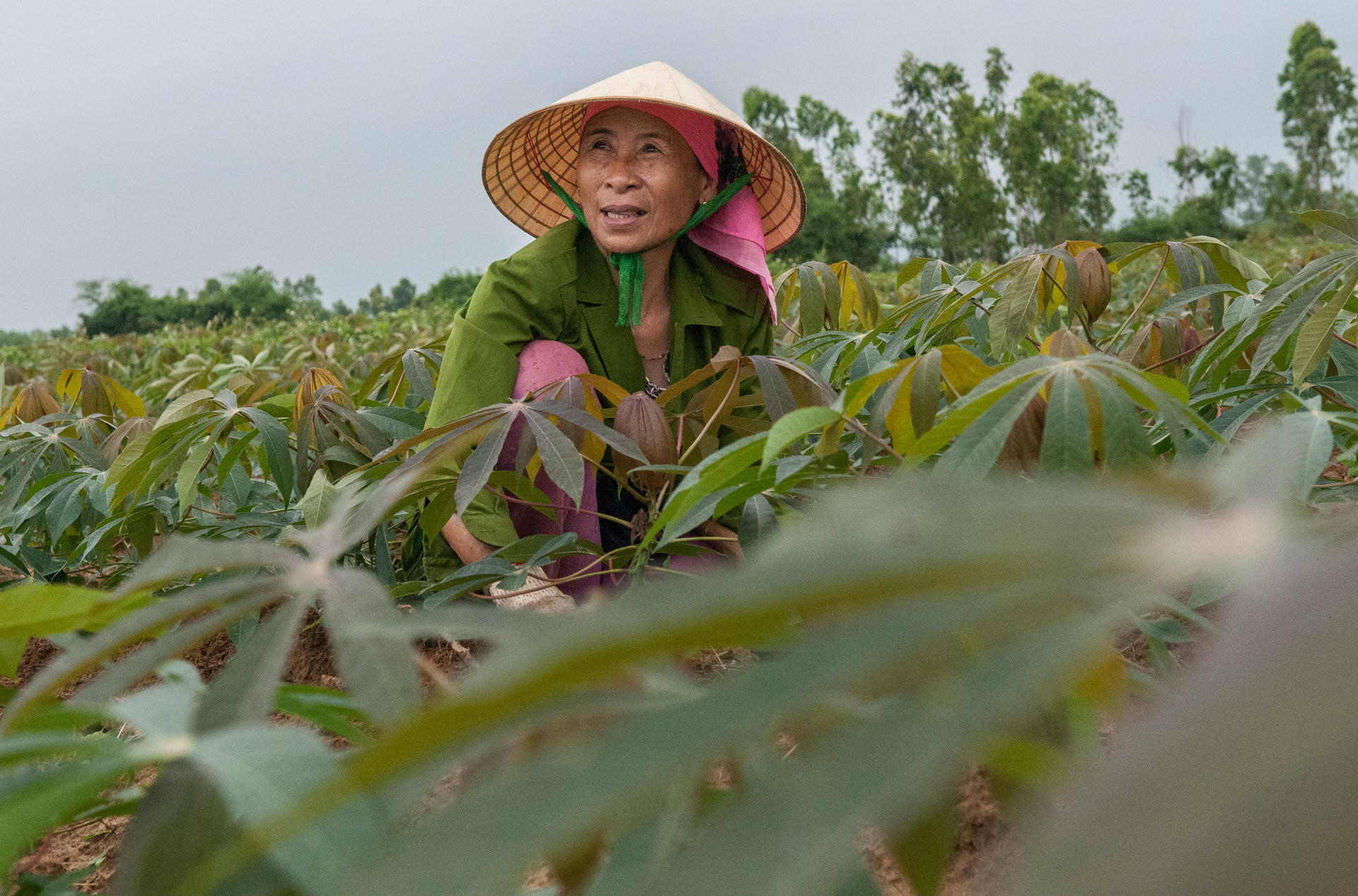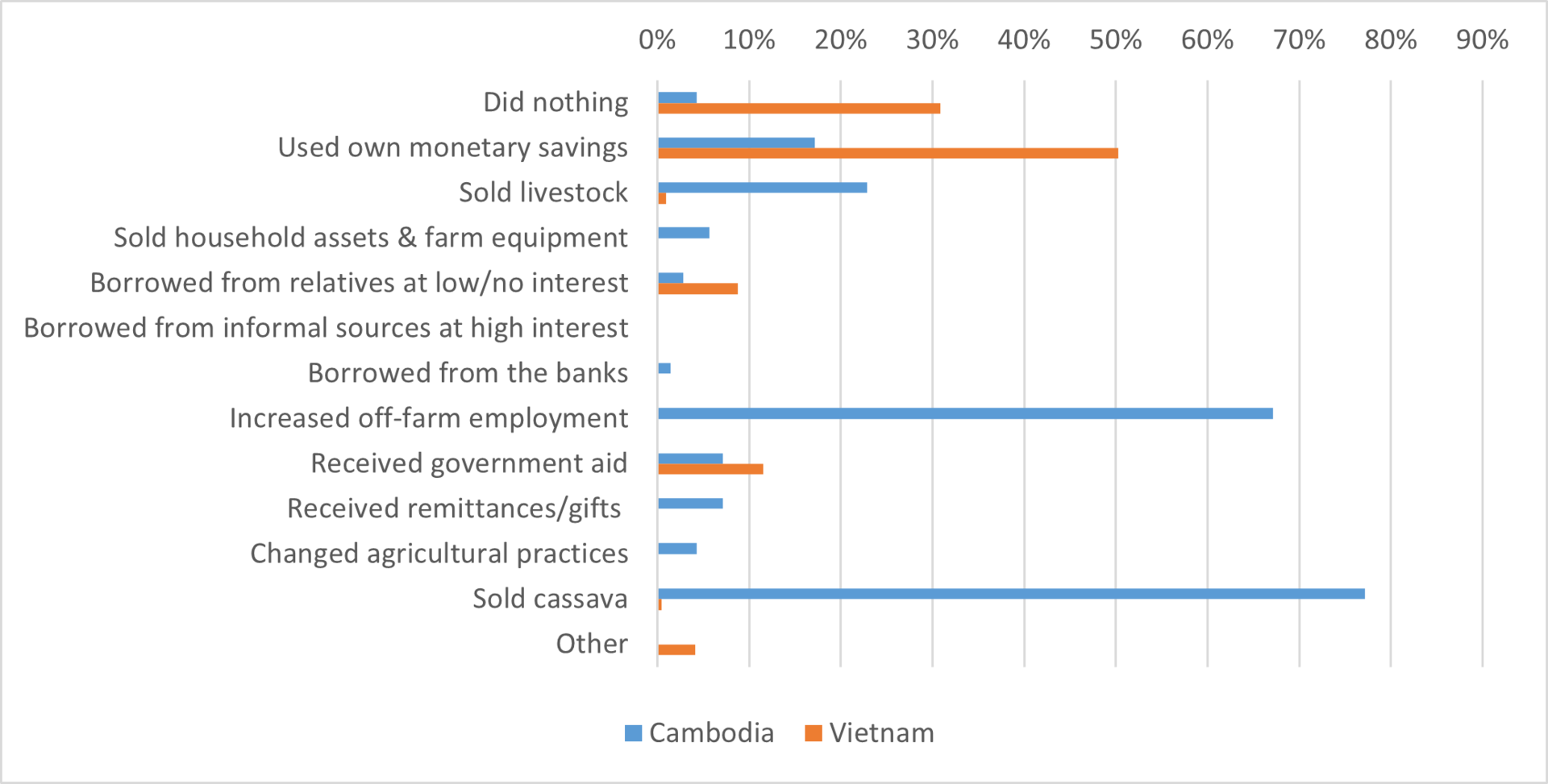Blog The Impacts of COVID-19 on Farmers' Income and Food Security In The Globalized Cassava Value Chains In Cambodia and Vietnam

Quang Binh, Vietnam, cassava processing. Farmers are trained in improved crop and soil fertility management.
©2015CIAT/GeorginaSmith
Scientists from the Alliance of Bioversity International and CIAT, led by Vanya Slavchevska, undertook a rapid study to gather evidence on the initial impacts of COVID-19 on cassava smallholders in Cambodia and Vietnam.
The research evaluates how smallholders coped with the economic consequences of COVID-19 in the short term, and whether livelihood diversification strategies mediated or exacerbated the impacts of the crisis.
The COVID-19 pandemic context
Cassava is a major industrial crop in Southeast Asia, cultivated to meet the growing global demand for starch, animal feed and bioethanol. It is largely cultivated by smallholder farmers, including some of the poorest upland farmers eking out a living on marginal land. The connection of these farmers to the vibrant, growing global cassava value chains has been credited with lifting many smallholder farmers in Southeast Asia out of poverty.
But alongside these benefits, engagement with globalized value chains has also been criticized as exposing smallholder farmers, many of whom do not have access to insurance or credit, to exogenous global shocks and hence to increased economic vulnerabilities and food and nutrition insecurity. This concern was highlighted by the COVID-19 pandemic, which prompted Southeast Asian governments to implement stringent measures restricting movement and border crossing in an effort to mitigate the spread of the virus.
The study focuses on the early phase of the pandemic (by the end of 2020) characterized by uncertainty and novelty in policy response. At the time, both Cambodia and Vietnam were relatively successful in containing the domestic spread of COVID-19.
Moreover, despite the COVID-19 pandemic, the global demand for cassava starch and chips was high in 2020, and cassava farmers were expected to benefit from high farm gate prices for cassava.
What did we find?
In the pivotal first year, despite strong policy responses and border restrictions, the pandemic did not cause major disruptions to the cassava value chains in the region. The demand for cassava remained strong and prices were high. However, we found that Cambodia and Vietnam experienced very different effects that can help us to learn about how each group coped with this new stressor.
In Vietnam, only 18% of cassava farmers reported any negative effects of the pandemic on cassava income. Farmers experienced more negative effects on their non-farming activities than on their actual farming (Figure 1). The poorest farmers that primarily grew cassava actually experienced smaller income shocks than wealthier households, whose incomes were diversified into non-farming sectors that suffered more from pandemic restrictions and impacts.
In Cambodia, 58% of cassava farmers reported negative impacts to their cassava income caused by the COVID-19 crisis (Figure 1). The poorest farmers, who were more dependent on cassava income, reported larger negative income shocks and experienced higher likelihood of food insecurity due to reductions in cash income.

Fig 1: The share of households reporting negative impacts of COVID-19 on different sources of income. Source: Authors' estimates. The values are conditional on anyone in the household participating in the respective income generating activity.
Why did they experience different effects?
Several factors affected the level of impact, including ad-hoc border restrictions and simultaneous unrelated environmental shocks from flooding. Importantly, as there are few cassava processing facilities within Cambodia, farmers rely on more complex value chains to export raw cassava roots or dried chips to neighbouring Thailand and Vietnam for processing or re-export. Ad-hoc border closures increased uncertainties involved with cross-border trade, and this was linked to fluctuations in prices - especially on the Thai border. Uncertainty provoked some farmers to sell their cassava crops early to cope with the crisis (Figure 2). Early harvesting also prevented some farmers from saving sufficient seed to re-plant their crops, leading to an additional expense in the next growing season.
Vietnamese cassava farmers used their own monetary savings to cope with the crisis in the short term (Figure 2). Buoyed by high cassava prices and supported by greater proximity to processing facilities, the economic toll was far lower than for their Cambodian counterparts.

Fig 2. Coping strategies by country. Source: Authors' estimates. The statistics are based on the responses of 70 (out of 79) farmers in Cambodia and 217 (out of 263) farmers in Vietnam who reported negative effects on income.
What major lessons did we learn?
Discriminatory border restrictions should be avoided, particularly for products with short shelf lives and limited domestic processing. Even transitory restrictions tend to affect the poorer more. With the harvest season for 2021-22 now beginning, government-to-government cooperation is needed to ensure that public health measures don’t cause serious economic stress for farmers involved in cross-border value chains.
The COVID-19 pandemic exposed how the dependence of Cambodia on its neighbors for processing capacity puts the cassava economy at risk during times of political uncertainty or other policy shocks. This provides a strong argument for policies that encourage investment in primary processing facilities located within Cambodia.
During the COVID-19 pandemic farmers in both Vietnam and Cambodia also experienced weather-related shocks and were already dealing with the impacts of cassava mosaic disease. Supporting farmers’ adaptation and enhancing resilience to climate-related shocks and pest and disease remains a priority we cannot afford to neglect during the global focus on response to the COVID-19 pandemic.
Developing robust value chains and market diversification strategies (including boosting domestic primary processing capacity) can help to ensure farmers are not exposed to future policy or market disruptions in cross border value chains for perishable crops like cassava. Policymakers should prioritize policies that strengthen value chain resilience to shocks, while avoiding the temptation to engage in reflexive measures that risk unintentionally penalizing the vulnerable.
Acknowledgements
This research was funded by the CGIAR Research Program on Policies, Institutions and Markets (PIM), the CGIAR Research Program on Roots, Tubers and Bananas (RTB) and the Australian Center for International Agricultural Research (ACIAR) under the project on Developing Sustainable Solutions for Cassava Disease in Mainland Southeast Asia.
The survey in Vietnam was carried out by the Agriculture Genetics Institute in Ha Noi and the Institute of Agricultural Sciences for Southern Vietnam in Ho Chi Minh City. The International Institute for Rural Reconstruction (IIRR) implemented the data collection in Cambodia.
The opinions expressed here belong to the authors, and do not necessarily reflect those of PIM, RTB, ACIAR, the Alliance of Bioversity International and CIAT or CGIAR. We declare no conflict of interests.

